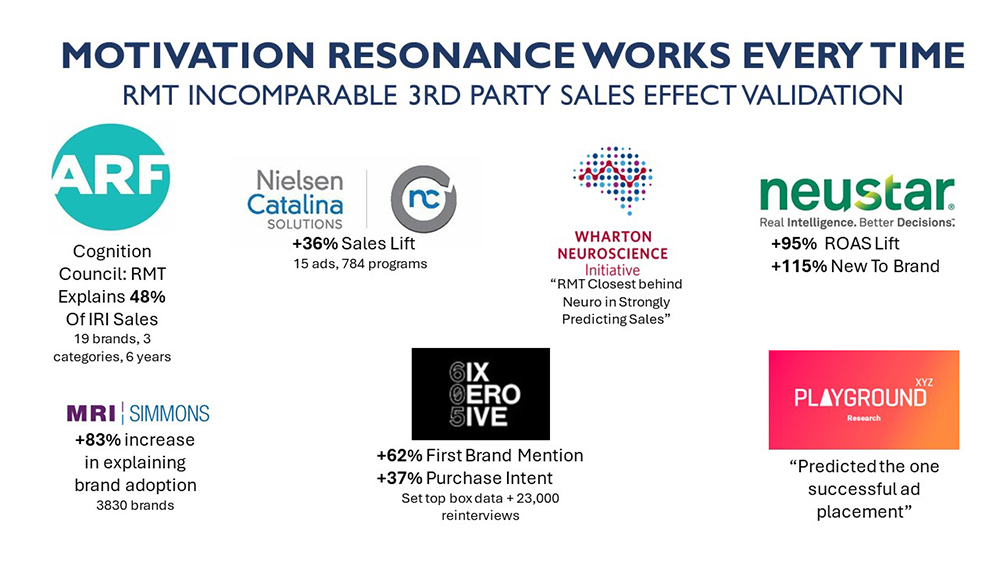The next revolution in advertising will erupt from a more scientific grounding for marketing theory. This will lead to:
1. A quantum leap in marketing insights
2. A more effective definition of relevancy to the individual consumer
3. Creative strategies with double the chance of success
4. Media selection placing the resonance of the ad experience on equal status with CPM.
The next revolution is already happening, and it is being brought about by neuroscience, AI, and empirically driven content coding.
Marketing science today is wrestling with questions whose answers will become clear in the light of this next revolution, because the subjective experience domain will become linked to the physically measurable domain.
Led by Byron Sharp and Jenni Romaniuk, the industry today believes that “Category Entry Points” (“CEPs”) account for 100% of the sales effect of advertising, and are the ultimate definition of what is relevant to the consumer in advertising. The number of CEP associations which consumers have with your brand and your brand’s share of all such associations in the category is your share of “Mental Availability”. The latter is defined as the probability that your brand will be considered in a buying choice situation. (Some say this model might be taken as somewhat pre-Behavioral Economics in the sense that it appears to assume rational behavior. However, this validated and practical model has brought clarity across the global marketing field and has earned everyone’s highest respect, including mine.)
CEPs are really a new name for “benefit segmentation”, the reasons why you pick one brand over another, tooth whitening or breath freshening or decay prevention and so on. These are valid inputs but only cover the conscious mind and are product specific. They are driven by factors which exist below the conscious level which are equally if not more important in choice behavior. For example, the desire for a toothpaste that provides breath freshening might be driven by a desire to find a mate. These subconscious (neuroscientists today prefer the term “implicit”*) factors need to be added into the CEP framework. The revolution makes this possible.
(*One of the top neuroscientists in the world today, Karl Friston, has put forth a compelling “Active Inference” model of what used to be called the subconscious.)
Neuroscience has discovered “Value Signals” in the brain. These are always present in a choice situation. Many parts of the brain are involved, and a few hundred different VS have been detected, which we and Wharton Neuroscience hypothesize could be the physical manifestation of RMT Value Signals (formerly known as DriverTags, of which there are 265) in the brain. This is where the neuroscience and empirically driven content coding come in. The AI comes in through the unique RMT Deep Learning Model and use of machine learning (ML), and through partner Semasio’s semantic AI tracking 700 million consumers globally.
The revolution will show that:
- Value Signals are what cause Mental Availability
- Value Signals also increase the probability that a brand will be bought (beyond Mental Availability)
- CEPs are a subset of what creates Value Signals
- The remaining potent VS are below the level of conscious awareness
- These new implicit VS actually drive the conscious CEPs.
Wharton Neuroscience and RMT have just announced their partnership which will focus on linking Value Signals with EEG and fMRI and household/people level sales. In the past, the linkages to sales used in marketing science theory development have too often not leveraged hard sales data at the most granular levels and were limited to laboratories. The Wharton Neuroscience RMT work will include in-home natural exposure measurement, linked to same-household/person sales. From this, the next revolution will come.
There is good reason to believe that this will work. Seven independent studies (see summary below) show that RMT is highly predictive of the sales effects of advertising, and use of RMT resonance metrics in media selection can increase those sales effects significantly. Wharton Neuroscience has worked with some of the top advertisers in the world and found four EEG signals that are also highly predictive of sales (memory encoding, brain attention, approach, and synchrony). Finally, Wharton Neuroscience and RMT measures are shown to predict each other, as one might expect given that they both predict sales. The strength of the next revolution rests upon this foundational work.

When the next revolution has become established, this will be the way marketers think:
Posted at MediaVillage through the Thought Leadership self-publishing platform.
Click the social buttons to share this story with colleagues and friends.
The opinions expressed here are the author's views and do not necessarily represent the views of